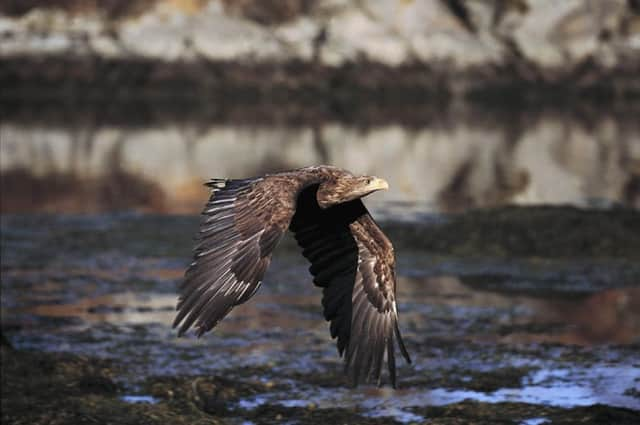Scottish sea eagle population set to soar


Counts in 2015 put the population at 106 pairs, but experts are predicting there will be at least 221 pairs by 2025. And they say this could rise to more than 1,000 pairs by 2040.
The sea eagle, or white-tailed eagle, is the UK’s largest bird of prey. It vanished from Scotland in 1917, but a reintroduction programme was launched in the 1970s with young birds from Norway.
Advertisement
Hide AdAdvertisement
Hide AdTo date there have been three releases – on the Isle of Rum from 1975 to 1985; in Wester Ross from 1993 to 1998; and in Fife from 2007 to 2013.
A population of mainly wild-bred Scottish birds now exists on the west coast, including Mull, Skye, the Small Isles and Outer Hebrides.
The birds released in Fife are just reaching breeding age, and the first successful nesting in eastern Scotland for around 200 years took place in 2013.
The report, authored by researchers at RSPB’s Centre for Conservation Science, considered a range of possibilities to predict the potential scale of the sea eagle population.
These included scenarios with no limits on population growth and others where suitable habitat, food and nest sites were not ideal or there were threats from collisions with wind farms or illegal persecution.
“We can be proud that the sea eagle is once again a key part of Scotland’s internationally renowned wildlife spectacle, enthusing local people and tourists alike,” said Duncan Orr-Ewing, head of species and land management at RSPB Scotland .
“Our population modelling work is showing that we can expect sea eagle numbers to gradually increase, and re-colonisation of much of the former range across Scotland will take place.
“Scientific evidence of this type will continue to play a critical role in determining future conservation actions.”
Advertisement
Hide AdAdvertisement
Hide AdThe report also considers how the species will spread across Scotland, and predicts the birds are most likely to expand their range along the west coast, the Great Glen and areas of central and eastern Scotland.
There have only been two recorded instances of sea eagle hitting turbines here, though evidence from Europe suggests the birds face a reasonably high risk of collision.
Illegal killing of sea eagles has been very rare to date but the situation could change as they spread into areas with a history of raptor persecution.
Environment and land reform minister Roseanna Cunningham, said: “This report shows the return of the white-tailed eagle to the skies over Scotland is a genuine conservation success story.
“That success has not been achieved easily, and I pay tribute to all of those whose efforts over many decades have helped us reach this point.
“This story also demonstrates the importance of working together to protect and enhance our natural environment.”